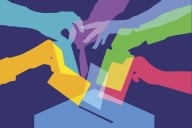You have /5 articles left.
Sign up for a free account or log in.
The COVID-19 pandemic has greatly affected the arts economy. Organizations large and small have shut their doors, refunded ticket sales and braced for a longer-term financial impact. That impact has led to furloughs, layoffs and closures -- and no one has been immune.
Venerated organizations like Cirque du Soleil, the Metropolitan Opera and the Boston Symphony Orchestra announced catastrophic changes to their staff, artists and art. Columbia Artists just announced they are closing for good. Unfortunately, these are not likely to be the last of these types of announcements we will see. Many theaters, symphony orchestras, museums and galleries of all sizes have already closed through spring 2021. Broadway itself will be dark until at least January 2021. These actions have been widely reported and financially devastating.
And yet this is the exact economic landscape in which higher education arts faculty are charged with preparing students for success. The fundamental responsibility to ready students for a sustainable arts career remains unchanged. But are the arts curricula of colleges and universities embedded with the skills students will actually need?
To be clear, higher education curriculum maps were problematic even before the pandemic. Outdated, they featured a range of courses that were originally designed to prepare students for a different economy. Curriculum maps that featured an overabundance of theory, history and traditional ensemble or studio experiences were meant to prepare students to enter full-time careers in symphony orchestras, studios and galleries. Those full-time arts jobs were already dwindling. COVID-19 may ultimately erase them from the arts economy altogether. Or, at the very least, the pandemic may make them so competitive that it will simply not be ethical to tell every student that they have a shot at those jobs.
So the pandemic has turned the spotlight onto what was an already glaring problem. What we have been teaching our arts students didn’t fully prepare them for this moment. Artistic excellence, appropriate understanding of theory and technique, and an appreciation for history and context will always remain essential. But successful and sustainable arts futures need more.
Consider the ways that art has continued throughout the pandemic. We’ve seen virtual concerts, Facebook Live events, Zoom play readings, online gallery tours, FaceTime tutorials and lessons, and many more offerings. Artists’ ability to create, innovate and continue to promote their art has been inspiring. It also took a lot of skills that exist beyond the narrow curriculum of skill development, theory and fundamentals, and history. Those events that artists continue to curate and execute require facility with technology, social media savvy, marketing and branding capacity, and the ability to fundraise and connect with donors. And many of these artists have been financially supported through grant programs that featured a written application. We could -- and should -- have been teaching these things all along.
Certainly, no curriculum committee or faculty member could have predicted the pandemic. But we cannot plead ignorance on the skills artists are currently using to create and promote their art. We simply can’t pretend that we didn’t know that a viable website and social media footprint was going to be important to a 21st-century artist.
But college and university curriculum committees are slow. In many ways, this deliberate speed is a good thing. It ensures that the faculty members are making thoughtful and meaningful decisions and that many types of constituents have an opportunity to contribute. Larger systemic changes to higher education arts curricula are absolutely needed and should still go through the slow, deliberate, faculty-led committee process.
But we have an urgent problem. The jobs landscape has already changed, and our graduates need these new skills now.
While a multifaceted problem, one of the answers is to change the presentation of the classes already included in the curriculum map. Imagine an art history course where students develop an Instagram account showcasing the career of Michelangelo. Or a music theory course where students learn the theory, compose their own piece and then record, edit and publish the new work to Creative Commons or SoundCloud. Or a band class where students decide the programming, book the venue and secure performance licenses. Or an acting student assigned to set up a YouTube channel for their monologues complete with logo, growth strategy and fundraising asks.
The pandemic has accelerated the change that was already taking place in the jobs landscape for the next generation of artists currently studying at our colleges, universities and conservatories. Faculty and administration in higher education arts programs must embrace this change immediately. As the quarantine has taught us, art will continue. And if higher education isn’t offering the training students need for success, artists will get the skills they need for this economy from somewhere else. Even if it means they build the plane while flying it.
No doubt many institutions across the country are already engaged in these necessary changes, mine included. They are daily adding innovative degree programs, new courses and clever pedagogy. But universal faculty buy-in is essential -- and not yet happening.
To teach these courses the same way they were always taught assumes that the available jobs after graduation are the same as they’ve always been. We know that is not true. In order to continue to enjoy the art, we must make sure we are properly training the artists.








